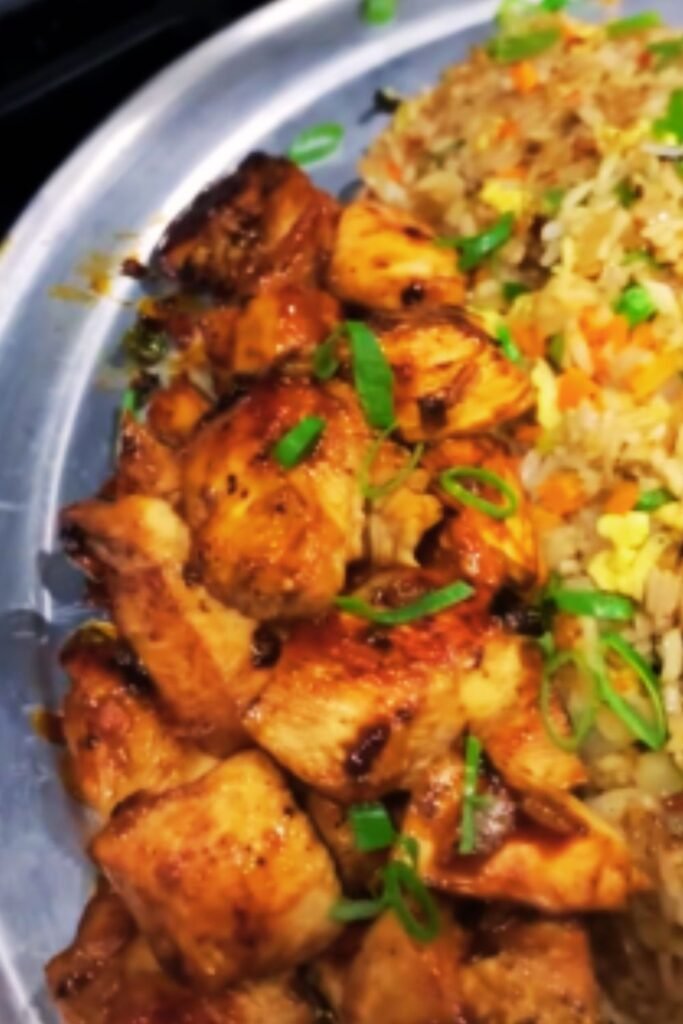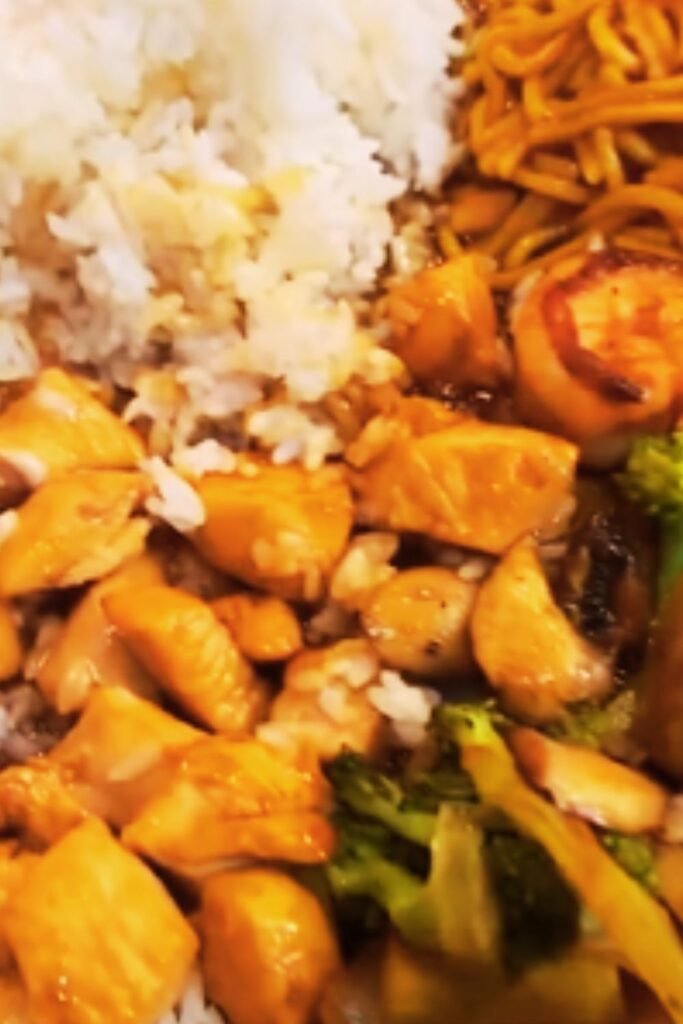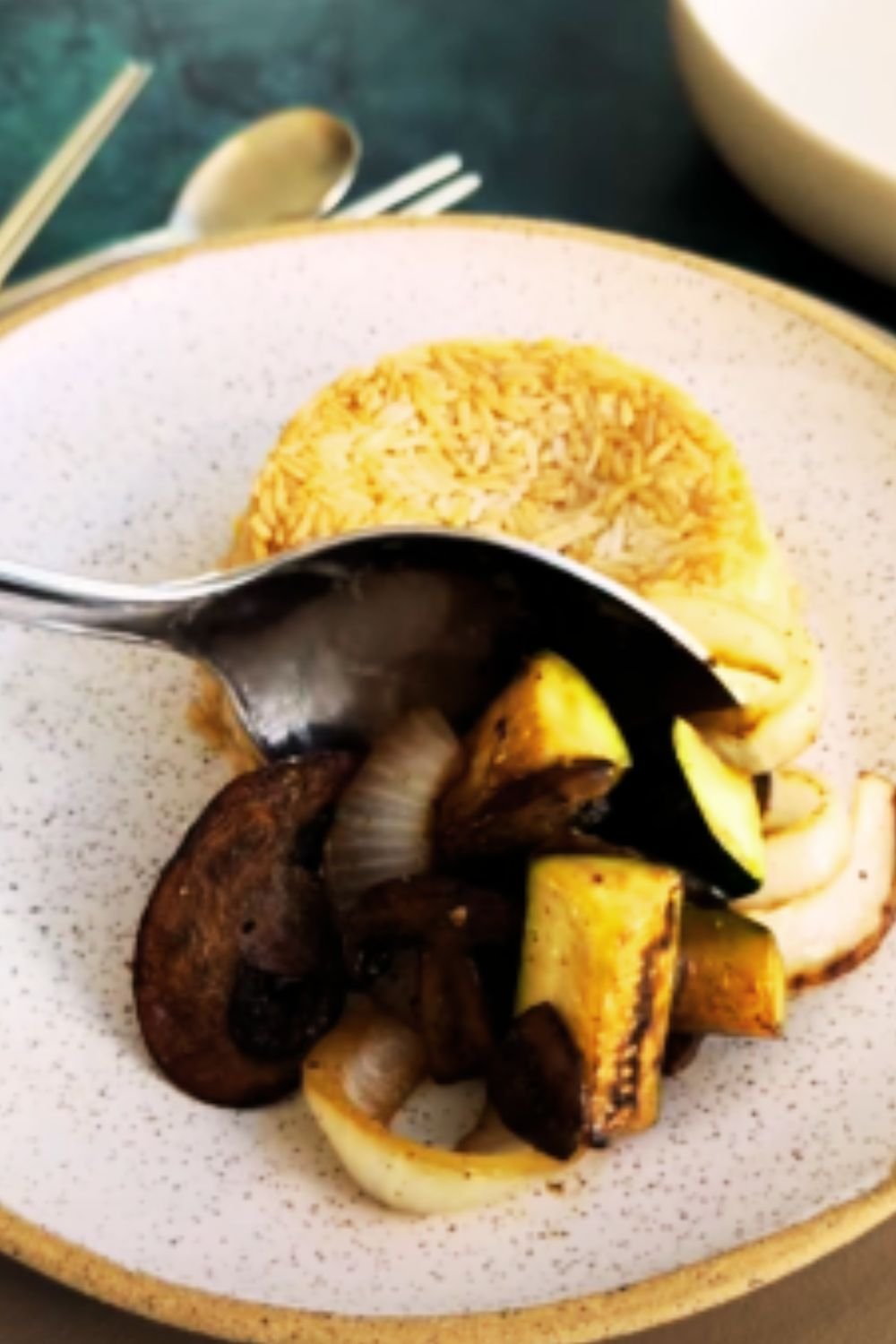There’s something undeniably mesmerizing about hibachi cooking. The sizzling sounds, tantalizing aromas, and theatrical flair of professional hibachi chefs turning simple ingredients into a magnificent feast never fails to impress. But what if I told you that you could recreate this magical experience in your own kitchen? Today, I’m sharing my tried-and-true recipe for the perfect Chicken and Steak Hibachi Combo that will transport your taste buds straight to your favorite Japanese steakhouse.
After years of experimenting with different techniques and ingredients, I’ve perfected the art of making restaurant-quality hibachi at home. The combination of tender chicken and juicy steak, alongside perfectly cooked vegetables and flavorful fried rice, creates a complete meal that’s impressive enough for special occasions yet simple enough for weeknight dinners. Let’s dive into the world of hibachi cooking and transform your kitchen into a Japanese steakhouse!
What Makes Hibachi Special?
Before we start cooking, let’s understand what hibachi really means. Hibachi (火鉢) literally translates to “fire bowl” in Japanese and traditionally refers to a heating device with an open-top container designed to hold burning charcoal. In modern Western restaurants, hibachi cooking has evolved to mean a style of cooking where chefs prepare food on a large, flat iron griddle right in front of diners.
What makes hibachi special is:
- The theatrical performance aspect of cooking
- High-heat cooking that seals in flavors
- Simple yet delicious seasoning that enhances rather than masks natural flavors
- Perfect timing that ensures meat is tender and vegetables retain their crunch
- The communal dining experience
Essential Equipment for Authentic Hibachi at Home
To recreate the hibachi experience at home, you’ll need a few key pieces of equipment:
Flat cooking surface : A large flat griddle, cast iron skillet, or electric griddle will work. The key is having enough surface area to cook multiple ingredients simultaneously while maintaining high heat.
Good quality knives : Sharp knives will help you achieve those perfectly uniform cuts that are characteristic of hibachi cooking.
Metal spatulas : Preferably with slightly rounded edges for easy flipping and moving of ingredients.
Squeeze bottles : For oils and sauces, allowing precise control over where liquids go on your cooking surface.

While professional hibachi chefs use specialized teppanyaki grills, you don’t need to invest in expensive equipment to achieve amazing results at home. I’ve found that a large cast iron skillet or griddle works wonderfully and creates that signature sear on the meat that we all love.
Ingredients for the Perfect Chicken and Steak Hibachi Combo
For the Proteins:
| Ingredient | Amount | Preparation |
|---|---|---|
| Boneless, skinless chicken breasts | 1 pound (450g) | Cut into 1-inch cubes |
| Ribeye or sirloin steak | 1 pound (450g) | Cut into 1-inch cubes |
| Vegetable oil | 2 tablespoons | For cooking |
| Sesame oil | 1 tablespoon | For flavor |
| Soy sauce | 3 tablespoons | Low sodium preferred |
| Garlic | 4 cloves | Minced |
| Fresh ginger | 1 tablespoon | Grated |
| Butter | 2 tablespoons | For finishing |
For the Vegetables:
| Ingredient | Amount | Preparation |
|---|---|---|
| Zucchini | 1 medium | Cut into half-moons |
| Onion | 1 large | Thinly sliced |
| Mushrooms | 8 ounces (225g) | Sliced |
| Carrots | 2 medium | Julienned |
| Bean sprouts | 2 cups | Rinsed and drained |
| Garlic butter | 2 tablespoons | Store-bought or homemade |
For the Hibachi Fried Rice:
| Ingredient | Amount | Preparation |
|---|---|---|
| Cooked white rice | 4 cups | Day-old rice works best |
| Eggs | 2 large | Beaten |
| Green onions | 4 stalks | Thinly sliced |
| Frozen peas and carrots | 1 cup | Thawed |
| Soy sauce | 3 tablespoons | Low sodium preferred |
| Butter | 2 tablespoons | Unsalted |
| Garlic | 2 cloves | Minced |
| Salt and pepper | To taste | For seasoning |
For the Signature Hibachi Sauces:
| Sauce Type | Ingredients | Preparation |
|---|---|---|
| Yum Yum Sauce | 1 cup mayonnaise, 2 tbsp ketchup, 2 tsp rice vinegar, 1 tsp sugar, 1/2 tsp paprika, 1/4 tsp garlic powder | Mix all ingredients until smooth |
| Ginger Sauce | 1/4 cup soy sauce, 1/4 cup rice vinegar, 2 tbsp grated ginger, 2 cloves minced garlic, 1 tbsp honey, 1 tsp sesame oil | Whisk all ingredients together |
| Mustard Sauce | 2 tbsp Dijon mustard, 2 tbsp soy sauce, 2 tsp honey, 1 tsp sesame oil | Combine and mix until smooth |
Preparation: The Key to Hibachi Success
Successful hibachi cooking relies heavily on proper preparation. In Japanese cooking, this concept is known as “mise en place” (everything in its place). Before you even heat up your cooking surface, make sure to:
- Cut all vegetables uniformly for even cooking
- Prepare proteins by cutting into equal-sized pieces
- Mix your sauces and place in squeeze bottles or small bowls
- Arrange all ingredients in the order you’ll use them
- Have serving plates ready and warmed if possible
This level of preparation makes the actual cooking process much smoother and more enjoyable, allowing you to focus on technique rather than scrambling to find ingredients.
Essential Hibachi Cooking Techniques
To achieve authentic hibachi results, master these key techniques:
High heat cooking : Preheat your cooking surface until it’s very hot. A drop of water should sizzle and evaporate immediately.
Quick movements : Keep ingredients moving to prevent burning while ensuring even cooking.
Cooking in stages : Cook proteins first, then set aside before cooking vegetables. This prevents overcooking and maintains ideal textures.
Proper seasoning : Use salt, pepper, and garlic butter at the right moments to build layers of flavor.
Theatrical flourishes : While not necessary for flavor, adding small showman-like gestures makes the experience more authentic and fun!
Step-by-Step Cooking Instructions
Marinating the Meats
For truly flavorful hibachi proteins, I recommend a brief marinade:
- In a bowl, combine 2 tablespoons soy sauce, 1 tablespoon minced garlic, and 1 teaspoon grated ginger
- Divide the marinade between two bowls
- Add chicken to one bowl and steak to the other
- Marinate for 15-30 minutes (not longer, as the soy sauce can begin to cure the proteins)
Cooking the Perfect Hibachi Fried Rice
- Heat your griddle or large skillet over medium-high heat and add 1 tablespoon vegetable oil
- Add beaten eggs and scramble quickly until just set, then push to one side
- Add 1 tablespoon butter to the empty side of the cooking surface
- Add day-old rice, breaking up any clumps with your spatula
- Combine the eggs and rice, then add frozen peas and carrots
- Drizzle with 2 tablespoons soy sauce and mix thoroughly
- Season with salt and pepper to taste
- Stir in sliced green onions just before serving
- Transfer to a serving dish and keep warm
Cooking the Hibachi Proteins
- Wipe down your cooking surface and raise heat to high
- Add 1 tablespoon vegetable oil and 1 teaspoon sesame oil
- When the oil is shimmering, add the marinated steak pieces in a single layer
- Cook for 1-2 minutes without moving, then flip and cook for another 1-2 minutes for medium-rare (adjust time for desired doneness)
- Add 1 tablespoon butter and a splash of soy sauce, then toss to coat
- Transfer steak to a warm plate
- Add another tablespoon of vegetable oil to the cooking surface
- Add chicken pieces in a single layer and cook for 2-3 minutes per side until golden and cooked through (internal temperature of 165°F/74°C)
- Add 1 tablespoon butter and a splash of soy sauce, then toss to coat
- Transfer chicken to the plate with steak

Cooking the Hibachi Vegetables
- Add remaining vegetable oil to the cooking surface
- Add sliced onions and cook for 1 minute
- Add mushrooms and cook for an additional minute
- Add zucchini and carrots, cooking for 2-3 minutes until vegetables are crisp-tender
- Finally, add bean sprouts and cook for just 30 seconds
- Add 1 tablespoon garlic butter, a splash of soy sauce, and season with salt and pepper
- Toss everything together and cook for another 30 seconds
Bringing It All Together
- Create sections on your serving platter for rice, vegetables, chicken, and steak
- Garnish with additional sliced green onions
- Serve with small bowls of yum yum sauce, ginger sauce, and mustard sauce
The beauty of hibachi is not just in the flavors but also in the presentation. I like to arrange components separately on the plate, allowing diners to combine ingredients as they prefer.
Expert Tips for Hibachi Perfection
After years of perfecting my hibachi technique, I’ve gathered these valuable tips:
- Use high smoke point oils like vegetable, canola, or peanut oil to prevent burning
- Don’t overcrowd your cooking surface – work in batches if necessary
- Pat meat dry before cooking to achieve better searing
- Rest your steak for at least 5 minutes before slicing to retain juices
- Cook vegetables in order of density – harder vegetables first, delicate ones last
- Keep extra soy sauce, garlic butter, and seasonings nearby for adjusting flavors while cooking
- Consider using tongs in addition to spatulas for easier handling of meat
Common Hibachi Cooking Mistakes to Avoid
Even experienced home cooks can fall into these hibachi pitfalls:
- Not getting the cooking surface hot enough – Hibachi relies on high heat for proper searing
- Overcooking the vegetables – They should retain some crunch
- Using freshly cooked rice – Day-old rice works better for fried rice as it’s drier
- Cutting meat with the grain – Always cut against the grain for tenderness
- Neglecting the power of butter – That rich finish is essential to authentic hibachi flavor
- Overcomplicated seasonings – Authentic hibachi relies on simple flavors done well
Serving Suggestions
A complete hibachi experience includes these accompaniments:
- Clear onion soup as a starter
- Salad with ginger dressing
- Hot green tea
- Chilled sparkling water with citrus
- Fresh fruit for dessert
For a truly authentic experience, consider setting up your cooking station where guests can watch you prepare their meal. The interactive element adds immensely to the enjoyment!

Storing and Reheating Leftovers
If you happen to have leftovers (which is rare in my household!), here’s how to store and reheat them properly:
- Store components separately in airtight containers in the refrigerator for up to 3 days
- For reheating, a quick stir-fry in a hot skillet is ideal
- Add a splash of water or chicken broth when reheating to restore moisture
- Add a fresh drizzle of soy sauce and a small pat of butter to revive flavors
Frequently Asked Questions
What’s the difference between hibachi and teppanyaki? Although these terms are often used interchangeably in the West, traditionally, hibachi refers to an open-topped ceramic bowl used for heating charcoal. Teppanyaki refers to the style of cooking on a flat iron griddle that we typically call “hibachi” in Western restaurants. What we know as hibachi in America is actually teppanyaki cooking.
Can I use chicken thighs instead of breasts? Absolutely! Chicken thighs will provide even more flavor and moisture. Just adjust cooking time slightly as thighs may take a bit longer to cook through.
What’s the best cut of beef for hibachi? Ribeye offers the best flavor due to its marbling, but sirloin and New York strip also work well. Avoid leaner cuts like filet mignon which can dry out with high-heat cooking.
How can I make vegetarian hibachi? Substitute the proteins with firm tofu or tempeh. Press tofu well before cooking to remove excess moisture and achieve better texture.
Is a special hibachi grill necessary? Not at all! While professional hibachi chefs use specialized equipment, at home you can achieve excellent results with a large cast iron skillet, griddle pan, or electric griddle.
What rice works best for hibachi fried rice? Medium or short-grain white rice works best. Cook it a day ahead and refrigerate overnight for optimal texture when making fried rice.
How do I achieve that smoky hibachi flavor at home? A touch of toasted sesame oil added at the end of cooking helps mimic that signature flavor. Some home cooks also use a drop of liquid smoke, though this isn’t traditional.
Can I prepare components ahead of time? Yes! Cut vegetables and proteins up to a day ahead and store in the refrigerator. Sauces can be made 2-3 days in advance. The actual cooking should be done just before serving.
Variations to Try
Once you’ve mastered the basic hibachi combo, try these delicious variations:
Seafood hibachi : Substitute shrimp, scallops, or salmon for chicken or steak. Seafood cooks quickly, so add it last.
Spicy hibachi : Add sriracha or chili garlic sauce to your base sauces for a spicy kick.
Teriyaki hibachi : Brush proteins with teriyaki sauce instead of the traditional soy-based sauce.
Garlic lover’s hibachi : Double the garlic in all components for an extra aromatic experience.
Hibachi noodles : Substitute yakisoba or udon noodles for rice for a different texture experience.
The beauty of hibachi cooking is its versatility. Once you understand the basic techniques, you can adapt it to suit your preferences and what’s available in your pantry.
The Perfect Entertaining Meal
Hibachi cooking isn’t just about delicious food—it’s about creating an experience. When I host hibachi nights at home, I:
- Set up my cooking station where everyone can watch
- Prepare all ingredients in advance in decorative bowls
- Pour sauces into attractive serving containers
- Provide chopsticks for an authentic touch
- Create a simple Japanese-inspired tablescape with low lighting
The interactive nature of hibachi cooking makes it perfect for date nights, family gatherings, or dinner parties. There’s something magical about gathering around as the meal is prepared, sharing conversation and anticipation as tantalizing aromas fill the air.
Hibachi cooking has brought so much joy to my kitchen and dining experiences. The combination of theatrical preparation, simple yet flavorful ingredients, and the complete meal experience makes it one of my favorite cooking styles. With this guide, you now have all the tools and knowledge you need to create a restaurant-quality Chicken and Steak Hibachi Combo right in your own home.
I hope this inspires you to fire up your griddle and start your own hibachi adventure. Happy cooking!


